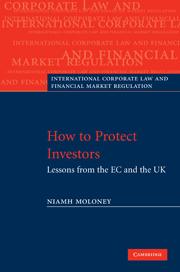Book contents
- Frontmatter
- Contents
- Preface and acknowledgments
- Table of cases
- Table of treaties and legislation
- List of abbreviations
- 1 The retail investor and the EC
- 2 Designing a retail investor protection regime
- 3 Product regulation
- 4 Investment advice and product distribution
- 5 Disclosure
- 6 The trading process
- 7 Education and governance
- 8 Supervision, enforcement and redress
- Index
Preface and acknowledgments
Published online by Cambridge University Press: 26 February 2010
- Frontmatter
- Contents
- Preface and acknowledgments
- Table of cases
- Table of treaties and legislation
- List of abbreviations
- 1 The retail investor and the EC
- 2 Designing a retail investor protection regime
- 3 Product regulation
- 4 Investment advice and product distribution
- 5 Disclosure
- 6 The trading process
- 7 Education and governance
- 8 Supervision, enforcement and redress
- Index
Summary
This book is concerned with the protection of retail or household investors. The retail markets can be something of a Cinderella in financial market regulation. The regulatory challenges can be humdrum but intractable, the retail constituency quiescent and unhelpful to the beleaguered regulator, and the empirical and analytical pyrotechnics of law and finance and of law and economics, typically applied to financial market regulation, often overlook this area; behavioural finance is, however, now taking up some of the empirical heavy lifting. But, as governments withdraw from welfare provision and promote stronger long-term household saving, the retail markets have become of central importance; to borrow a phrase from law and finance, they ‘matter’. So does investor protection regulation and how it is developed and designed.
This book accordingly addresses three questions. Who is the retail investor (chapter 1)? Why should that investor be protected (chapter 2)? How should protection be designed (chapters 3–8)? It considers whether investors are best characterized as empowered, irrational or trusting, and considers the implications for regulatory design. Its case study is the massive EC harmonized regulatory regime for Member States' retail investment markets which provides a rich case study of investor protection law ‘on the books’. But effective retail market protection depends heavily on ‘law in action’, which remains largely the preserve of the Member States. The book's main case study for domestic ‘law in action’ is the UK and, in particular, the retail market activities of the Financial Services Authority.
- Type
- Chapter
- Information
- How to Protect InvestorsLessons from the EC and the UK, pp. xiii - xviPublisher: Cambridge University PressPrint publication year: 2010

